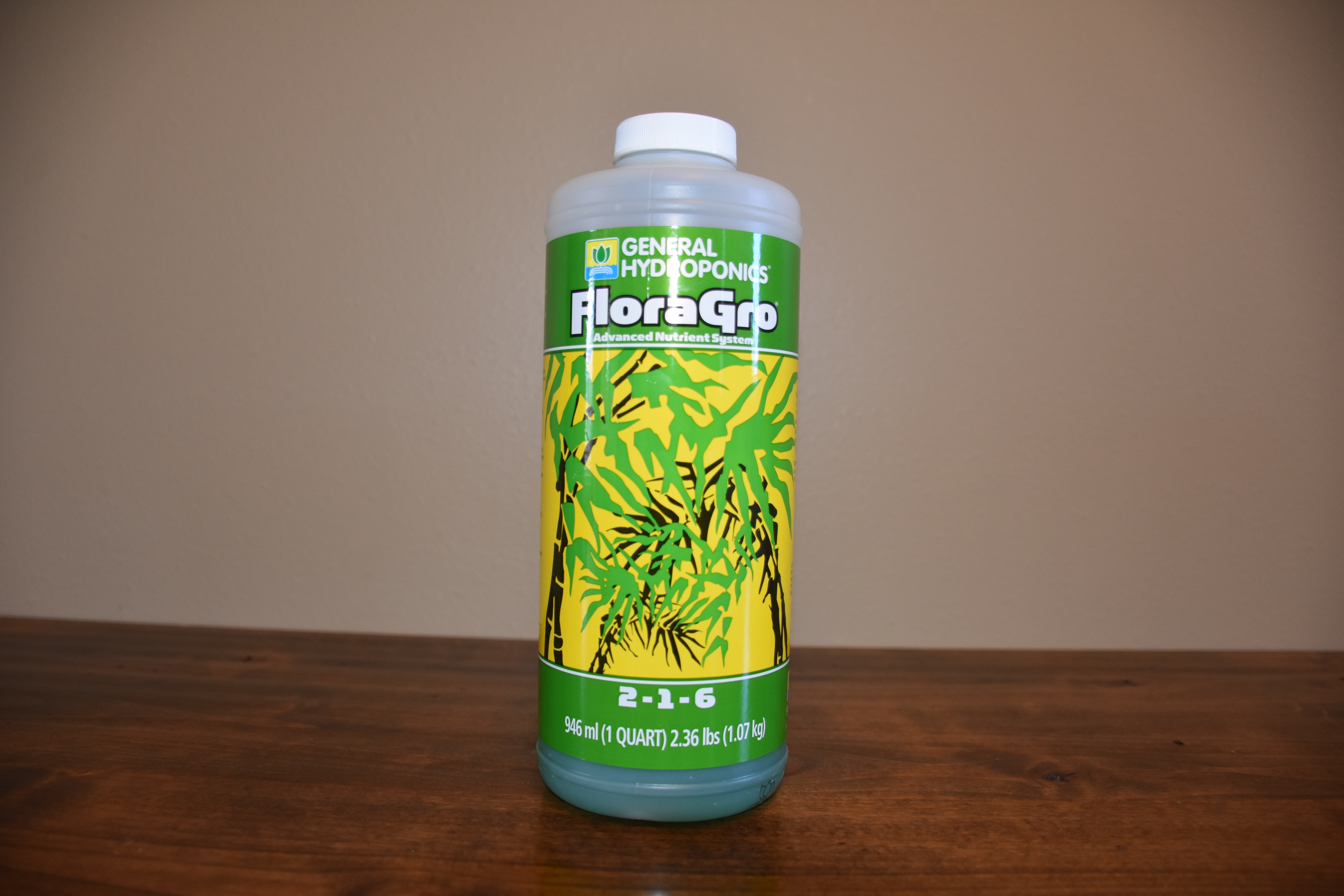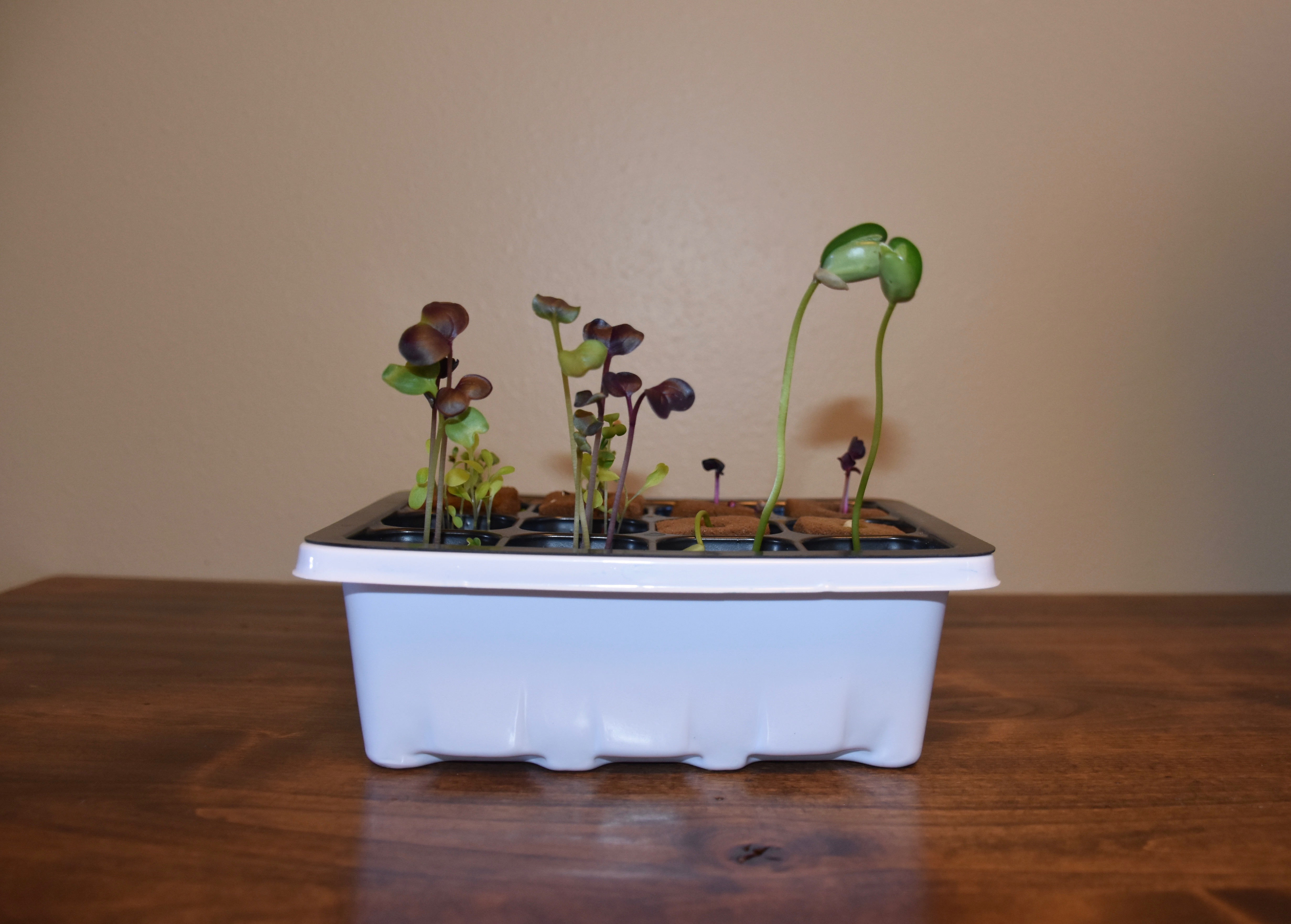Agricultural Literacy Curriculum Matrix
Lesson Plan
Test Tube Hydroponics
Grade Level
3 - 5
Purpose
Students investigate the importance of nutrients for plant growth and discover how plants grow without soil by growing and observing plants in a test tube hydroponic system. Grades 3-5
Estimated Time
1 hour of instruction plus 1 week for germination and 1 month of observation
Materials Needed
Engage:
Activity 1: Plant Nutrients
- Plants Growing in Soil photo4
- Plants Growing in a Hydroponic System photo5
- Hydroponic nutrient solution container or Hydroponic Nutrient Solution Photo
- Plant Nutrients handout
Activity 2: Test Tube Hydroponics
- Rockwool*, 1 cube per student
- Seed-starter tray*, 1 space per student
- Soybean seeds*, 1 per student
- Plant tags*, 1 per student
- Permanent markers
- Plastic, flat-bottom test tubes*, 1 per student
- Bowl of water, 1 per group
- Pipettes*, 1 per student
- Bowl of hydroponic nutrient solution mixed with water (We tested 1/4 tsp of General Hydroponics FloraGro per 1 gallon of water.)
- 1 gallon container (A milk or juice container works great.)
- Aluminum foil
- Rubber gloves
- Safety glasses
- Plant Observation Sheets
*These items are included in the Test Tube Hydroponics Kit, which is available for purchase from agclassroomstore.com. A Test Tube Hydroponics Refill Kit is also available.
Vocabulary
agronomist: a scientist who studies soil management and crop production
conserve: to prevent waste or loss of; to use or manage wisely
fertilizer: any material of natural or synthetic origin that is applied to soils or plant tissues to supply one or more nutrients essential to plant growth
growing medium: a substance through which plant roots grow
hydroponics: the method of cultivating plants using a mineral nutrient solution in a water solvent without the use of soil
non-arable: not suitable for the growing of crops
nutrient: a substance that provides nourishment essential for growth and the maintenance of life
nutrient solution: liquid fertilizer used in hydroponics
Did You Know?
- During World War II, locally established hydroponic systems were used to grow fruits and vegetables to feed the US Armed Forces stationed on non-arable islands in the Pacific.2
- Growing plants hydroponically allows farmers to better control the growing environment, including the temperature. By controlling the temperature inside the greenhouse, farmers are able to extend the growing season for fresh produce, nearly year-round.3
- Hydroponic systems can be used indoors or outdoors. The systems can be set up to use either natural sunlight or artificial grow lights.
Background Agricultural Connections
Hydroponics, the science of growing plants without soil, is at least as old as the Egyptian pyramids. As a farming tool, it is believed to have started with the hanging gardens in the ancient city of Babylon. The Aztecs created floating gardens by building rafts of rushes and reeds that held crops of vegetables and flowers.
In 1699, John Woodward, a fellow of the Royal Society of England, experimented with growing plants in a liquid medium. Following Woodward's research, European plant physiologists proved that water is absorbed by plant roots, passes through the plant stem system, and escapes into the air through pores in the leaves. They showed that plant roots take up minerals through water.
In 1860, Julius von Sachs, professor of botany at the University of Würzburg, published the first standard formula for a nutrient solution that could be dissolved in water and in which plants could be successfully grown.
In 1936, W.F. Gericke and J.R. Travernetti, from the University of California Berkeley, published an account of the successful cultivation of hydroponic tomatoes. From this study, commercial growers began experimenting with the technique, and researchers and agronomists began working to simplify and perfect the process.
Today, hydroponics is the term used to describe the many varied ways plants can be raised without soil. Plants need air, light, water, and nutrients to grow. Plants do not need soil. They need the nutrients and moisture that can be found in soil. Soil also serves the purpose of anchoring the plant. In a hydroponic system, a growing medium—such as rockwool, perlite, vermiculite, coconut fiber, gravel, sand, clay pellets, etc.—is used to anchor the plant, and a nutrient solution, containing all of the essential elements needed by the plant for its growth and development, is added.
Nutrients are essential to plant growth. Nitrogen (N), phosphorus (P), and potassium (K) are primary macronutrients. The positive effects of the presence of these nutrients at optimum levels and the negative effects of deficient or excess levels can be visually observed in plants.
Nitrogen (N):
- Optimum: Plants are rich green and the protein content increases.
- Deficient: Plants are stunted and light green in color, the lower leaves are yellow, and the stem is slender.
- Excessive: Plants have a very lush foliage with sappy, soft stem and flowering is delayed.
Phosphorus (P):
- Optimum: Phosphorous stimulates root formation and growth, giving the plants a vigorous start. Phosphorous also stimulates flowering and aids in seed formation.
- Deficient: Plants have slower growth and delayed flower and pod development, the leaves are dark green and dull, the root system is poor with little branching, and the stem is slender
- Excessive: Plants have very lush foliage with sappy, soft stems and flowering is delayed.
Potassium (K):
- Optimum: Potassium imparts increased vigor and disease resistance.
- Deficient: Leaves can be mottled or chlorotic, small necrotic spots may appear between veins or near leaf tips and margins, the flowers do not achieve vibrant yellow color, and the stem is slender.
- Excessive: Plants have dark foliage, stiff stems, and leaf branches.1
Hydroponics allows for greater control over the growing process, therefore providing consistent results. Because the soil is replaced with a sterile growing medium, the risks of soil-borne diseases and pests are eliminated and there are no weeds. More plants can be grown in a smaller space. Plants mature faster and produce greater yields. Water and fertilizer are conserved due to their ability to be reused. Hydroponics is a viable option for growing plants in highly populated areas or locations with non-arable land or harsh climates. Hydroponic systems can be found on remote islands, submarines, the International Space Station, Antarctic research stations, and off-shore drilling rigs.
Engage
- Have the students make a list of what plants need to grow. Write every requirement the students come up with on the board, regardless of whether or not it is correct .
- Ask the students, "Do plants need soil?"
- Show the class the How Does it Grow? Hydroponic Spinach video.
- Refer back to the question, "Do plants need soil?" Discuss the hydroponic system from the video as evidence that plants can be grown without soil. Define hydroponics as the science of growing plants without soil.
- Refer back to the students' list of plant needs. Circle (or add and circle) the four main growth requirements—air, light, water, and nutrients.
Explore and Explain
Activity 1: Plant Nutrients
- Show the students the Plants Growing in Soil photo. Ask the students to point out where the plant nutrients are found in the picture.
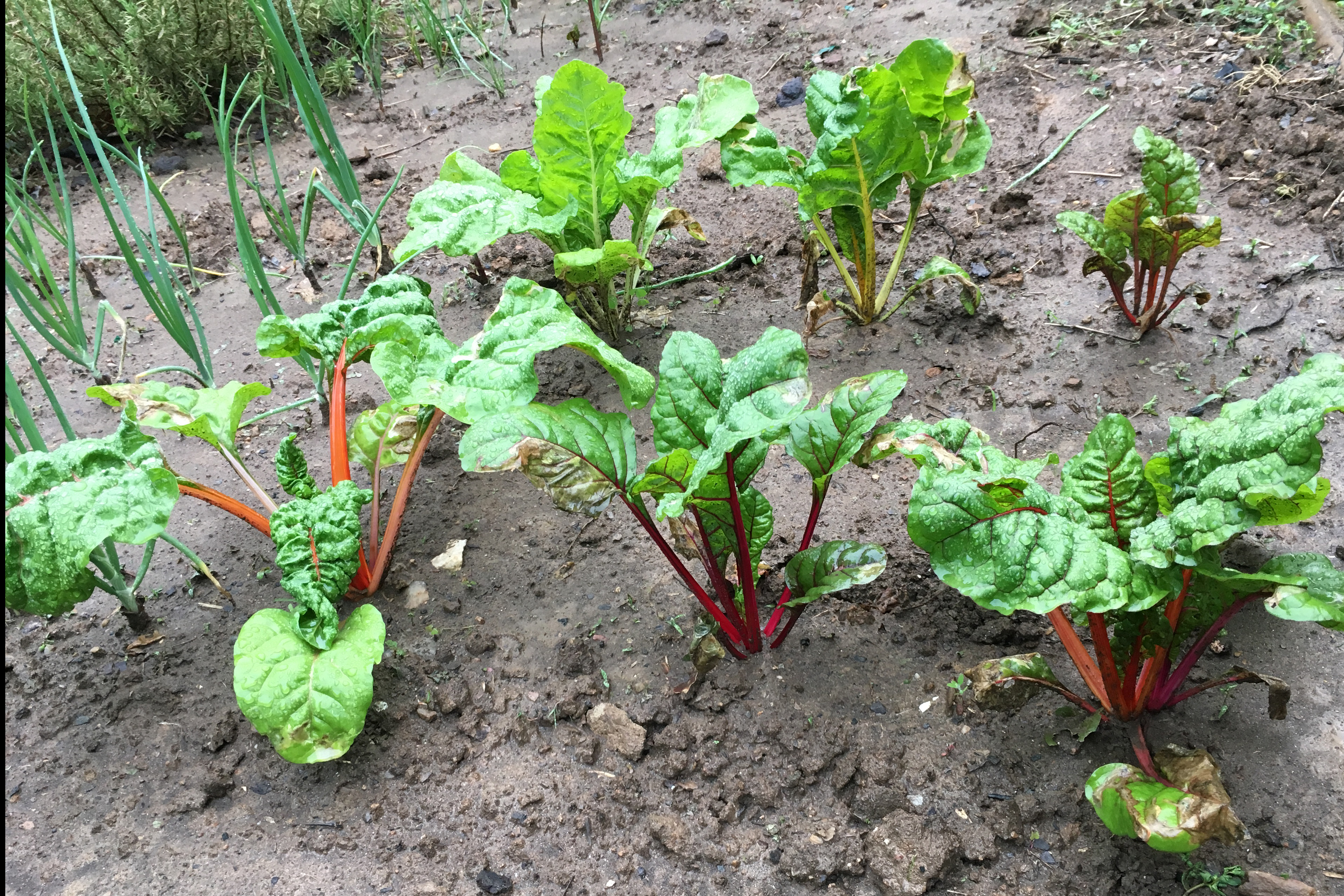
- Discuss how plants growing in soil receive nutrients. Use the following points to guide the discussion:
- Soil contains nutrients.
- Fertilizer can be applied to the soil to add nutrients that may be deficient.
- Plants absorb nutrients and water from the soil through their roots.
- Show the students the Plants growing in a Hydroponic System photo. Ask the students to point out where the plant nutrients are found in the picture.
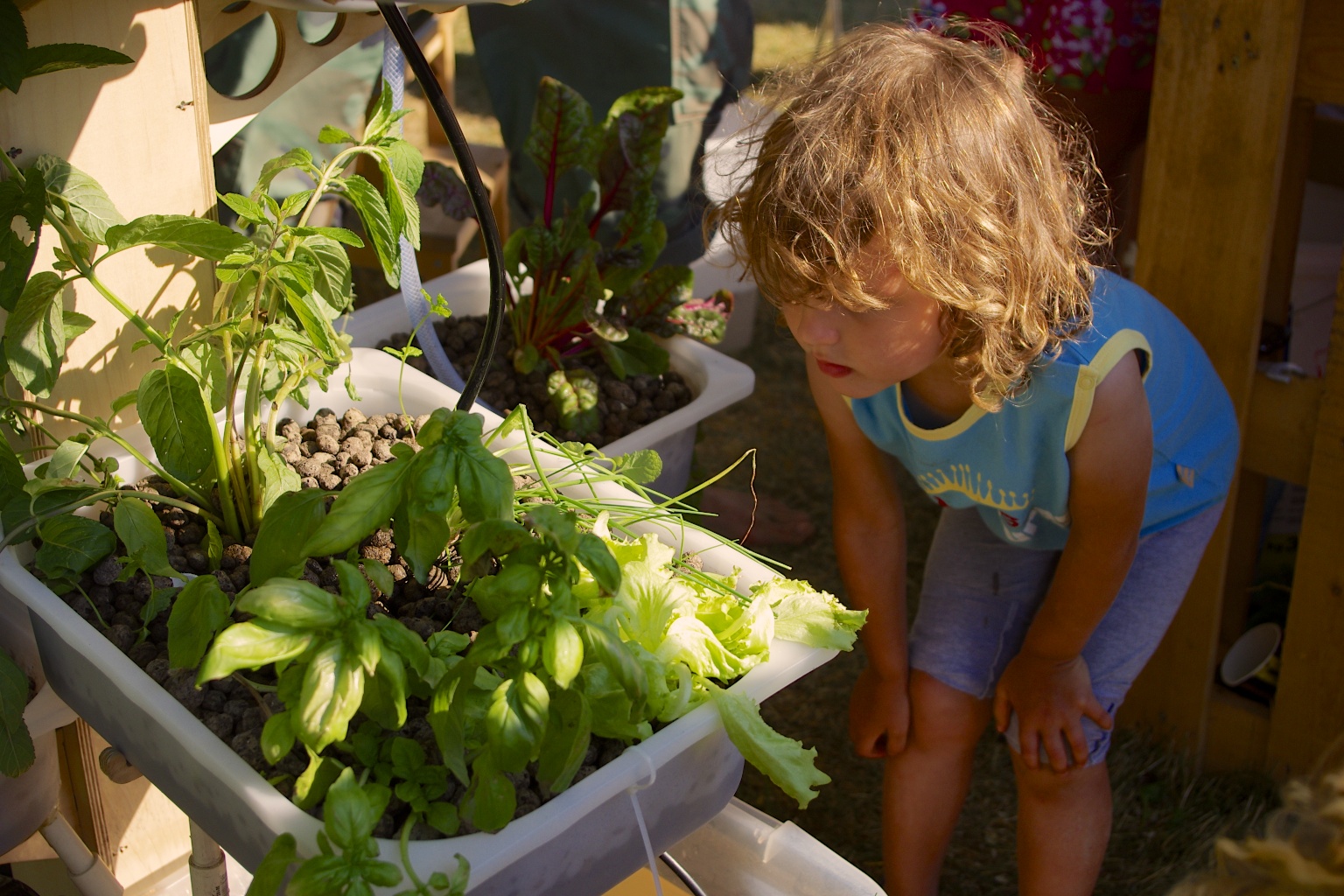
- Discuss how plants growing in a hydroponic system receive nutrients. Use the following points to guide the discussion:
- Plants grown hydroponically are not grown in soil.
- Nutrients are delivered through a nutrient solution that is added to water.
- Plants absorb water and nutrients from the solution through the plant roots.
- Show the students a container of hydroponic nutrient solution or the Hydroponic Nutrient Solution Photo. Point out the three numbers on the container. Explain that these numbers represent the percentage of nitrogen (N), phosphorus (P), and potassium (K) in the solution.
- Use the information in the Plant Nutrients handout to discuss the importance of N, P, and K for plant growth and what happens when too little or too much of each nutrient is present.
| Nitrogen (N), phosphorus (P), and potassium (K) are primary macronutrients. While these primary macronutrients are the focus of nutrient (fertilizer) application programs, hydroponic nutrient solutions can also contain secondary macronutrients—calcium, magnesium, and sulfur—and micronutrients. Many nutrient solutions are also pH balanced to aid in the plant nutrient absorption process. |
Activity 2: Test Tube Hydroponics
- Explain to the class that they are going to try to grow plants without soil. They will conduct an investigation to determine the importance of nutrients to their plants' growth.
- Organize the students into groups of two. Each group will germinate seeds in two test tubes, one containing water and the other containing a hydroponic nutrient solution and water. Once the plants germinate, the students will track the growth of each plant.
- Have each student place a rockwool cube into a seed-starter tray. Place a soybean seed into the center hole of the rockwool cube and water the cube. Have the students label their spaces in the tray by writing their name on a plant tag and inserting it into the rockwool. When all students have planted their seeds, place the clear lids onto the trays.
- Ask the students, "What do seeds need to germinate?" (air, moisture, and warmth)
- As a class, discuss how the germination requirements will be met for the seeds in their test tubes. (There is air in the seed-starter trays and the rockwool holds water which provides moisture for the seeds. Placing the seed-starter trays by the window can provide warmth from the sun.)
- Explain to the students that it will typically take about 3-7 days for the seeds to germinate.
- After the roots are growing down past the bottom of the rockwool (about one week), a teacher or other adult should prepare the nutrient solution in a gallon container by combining the fertilizer with water per the instructions on the fertilizer container for seedlings. Safety Note: Use rubber gloves and safety glasses when handling fertilizer to avoid contact with skin and eyes.
- Organize students back into their groups. Provide each group with a bowl of water (labeled), a bowl of nutrient solution (labeled) two test tubes, two pipettes, rubber gloves, and safety glasses.
- Using a permanent marker, have the students label one of their test tubes "water" and the other "nutrient solution." Both test tubes should also be labeled with their names and the date.
- Using a pipette, have one student from each group draw water from the bowl and fill the test tube labeled "water" to the 35 mL mark. The other student will wear rubber gloves and safety glasses and will use a pipette to draw nutrient solution from the bowl and fill the test tube labeled "nutrient solution" to the 35 mL mark. Pipettes should be saved to add water and nutrient solution to the corresponding test tubes as needed.
- Each student should carefully place the rockwool with their seedling into the test tube they prepared so that the top lip of the rockwool rests on the top edge of the test tube and the roots, but not the rockwool, are in the liquid.
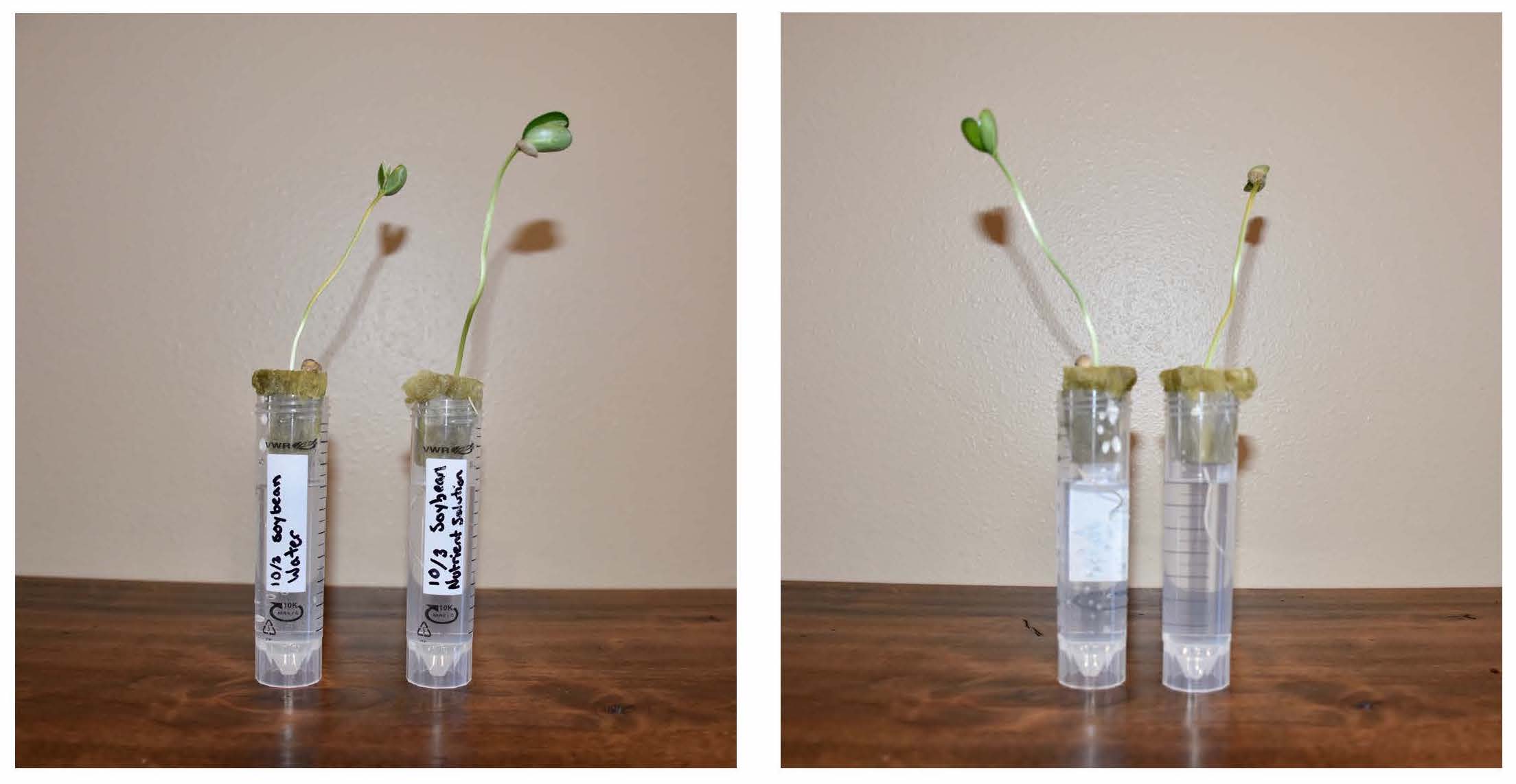
- Wrap aluminum foil around the outside of each test tube, and place the test tubes by a sunny window or under a grow light.
- Ask the students, "Now that the seeds have germinated, what will the plants need to grow?" (air, water, light, and nutrients)
- Ask the students to make predictions about how the plants in each test tube will grow. Will all of the plant needs be met?
- Provide each student with a set of Plant Observation Sheets. Have the students record their observations twice a week for one month. Use the pipettes to add water and nutrient solution to the corresponding test tubes as needed to maintain the level of the liquid at 35 mL.
- After one month, lead a discussion comparing the plant in the "water" test tube with the plant in the "nutrient solution" test tube. Use the following questions to guide the discussion:
- Can plants be grown without soil?
- Did the soybean plants grow better in the water or the nutrient solution?
- What did you observe as the plants were growing?
- What conclusions can be drawn?
- What are the benefits of growing plants in hydroponic systems? (allows for greater control over the growing process with consistent results; eliminates risks of soil-borne diseases, pests, and weeds; more plants can be grown in a smaller space; plants mature faster and produce greater yields; water and fertilizer can be reused; plants can be grown in highly populated areas or locations with non-arable land or harsh climates)
Elaborate
-
Explore how hydroponic systems are supplying fresh produce in locations where food cannot be conventionally grown by viewing these videos: Hydroponics in Antarctica and Space in 4K – First Lettuce Grown and Eaten in Space videos.
Evaluate
After conducting these activities, review and summarize the following key concepts:
- Plants need air, water, light, and nutrients to grow.
- Nutrients are found in soil. Plants can grow without soil if they receive nutrients from another source.
- Hydroponics is the science of growing plants without soil.
Sources
- https://fastplants.org/wp-content/uploads/2017/02/WFPphysiology-06web.pdf
- http://www.rain.org/global-garden/hydroponics-history.html
- https://www.mdac.ms.gov/wp-content/uploads/fts/hydroponiccucumbers.pdf
- Photo Credit woodleywonderworks
- Photo Credit Maciej Wojnicki
Recommended Companion Resources
Author
Lynn Wallin
Organization
National Center for Agricultural Literacy
| We welcome your feedback! If you have a question about this lesson or would like to report a broken link, please send us an email. If you have used this lesson and are willing to share your experience, we will provide you with a coupon code for 10% off your next purchase at AgClassroomStore. |

